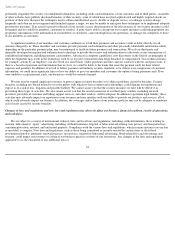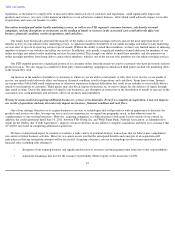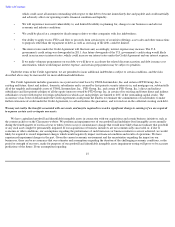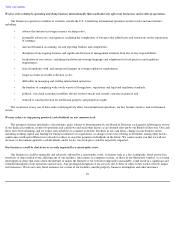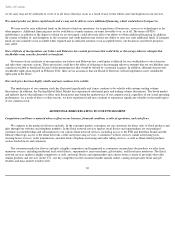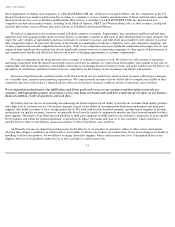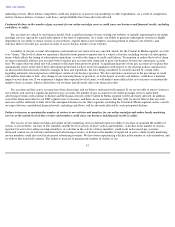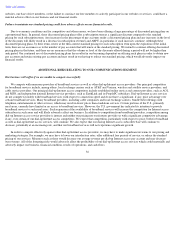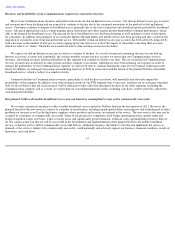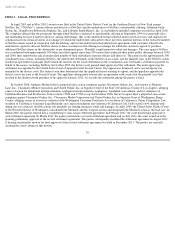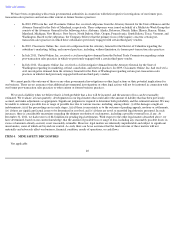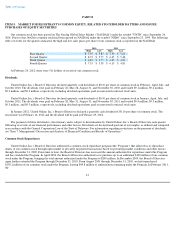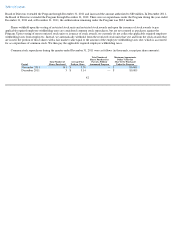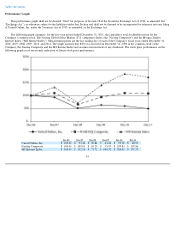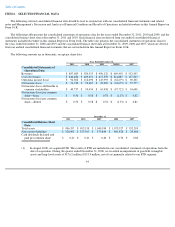NetZero 2011 Annual Report Download - page 36
Download and view the complete annual report
Please find page 36 of the 2011 NetZero annual report below. You can navigate through the pages in the report by either clicking on the pages listed below, or by using the keyword search tool below to find specific information within the annual report.
Table of Contents
decrease our ability to compete with traditional retailers and reduce our sales, which could have a material adverse effect on our business,
financial condition, results of operations, and cash flow.
We utilize outsourced staff and temporary employees, who may not be as well trained or committed to our customers as our permanent
employees, and their failure to provide our customers with high-
quality customer service may cause our customers not to return, which could
have a material adverse effect on our business, financial condition, results of operations, and cash flows.
We utilize and rely on a significant number of outsourced staff and temporary employees in addition to our permanent employees, to take
orders and respond to customer inquiries. These outsourced staff and temporary employees may not have the same level of commitment to our
customers or be as well trained as our permanent employees. In addition, we may not hire enough outsourced staff or temporary employees to
adequately handle the increased volume of telephone calls we receive during peak periods. If our customers are dissatisfied with the quality of
the customer service they receive, they may not place orders with us again, which could have a material adverse effect on our business, financial
condition, results of operations, and cash flows.
ADDITIONAL RISKS RELATING TO OUR CONTENT & MEDIA SEGMENT
We face intense competition that could result in the failure of our online nostalgia services to be commercially successful.
As consumers continue to spend more time and money online, the competition for their time and engagement has continued to intensify.
Consumers have a great number of options for online content and entertainment, including, by way of example, games, websites offering news
and current events, movies, television shows, videos, information about any and virtually every topic, and the opportunity to communicate,
socialize and interact with acquaintances and others. Certain aspects of the value proposition of our online nostalgia services compete with major
social networking websites such as Facebook and Google+ as well as Internet search engines such as Google. Many of our competitors offer
their content and services free of charge.
The market for online loyalty marketing services is highly competitive, and we expect competition to significantly increase in the future as
loyalty marketing programs continue to grow in popularity. Our MyPoints online loyalty marketing service faces competition for members from
other online loyalty marketing programs as well as offline loyalty marketing programs that have a significant online presence, such as those
operated by credit card, airline and hotel companies. In addition, we also face competition for members from online providers of discounted
offerings and coupons, such as Groupon and LivingSocial.
Some of our competitors have longer operating histories, greater name and brand recognition, larger user bases, significantly greater
financial, technical, sales, and marketing resources, and engage in more extensive research and development than we do. Some of our
competitors also have lower customer acquisition costs than we do, offer a wider variety of services, have more compelling websites with more
extensive user-generated or third-party content or offer their services or content free to their users. Some of our competitors have been more
successful than we have been in attracting and retaining visitors and members, and our ability to attract visitors to our websites and maintain a
large and growing member base has been adversely affected by such competition. In particular, Facebook's membership base currently far
exceeds that of any of its competitors, and Google+ has been growing its membership base at a rapid pace. We rely on some of our competitors
to promote our services and for new member acquisitions, such as our Facebook high school fan pages. If our competitors provide services
similar to our online nostalgia services for free, we may not be able to charge for our online nostalgia services. Competition has adversely
affected our subscription revenues from online nostalgia services, as well as our advertising revenues from our online nostalgia services and
online loyalty
34


